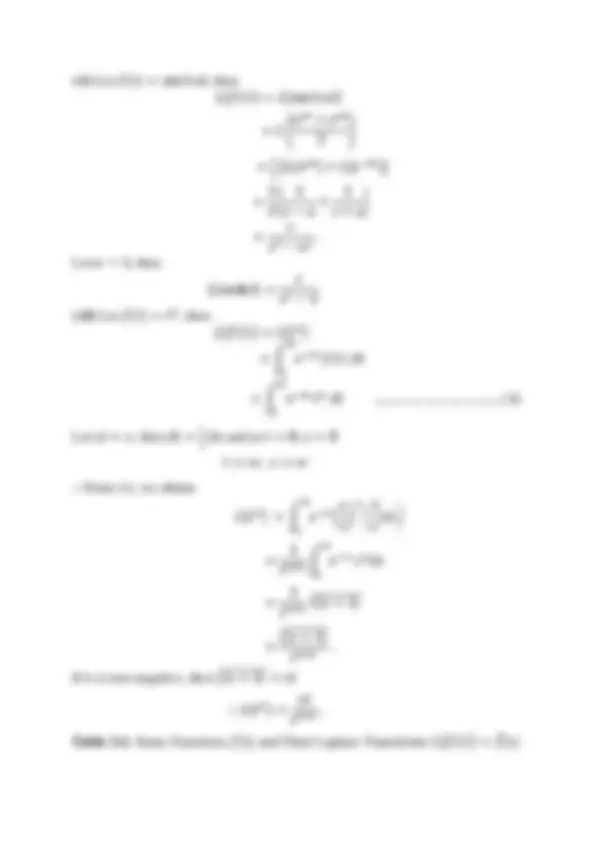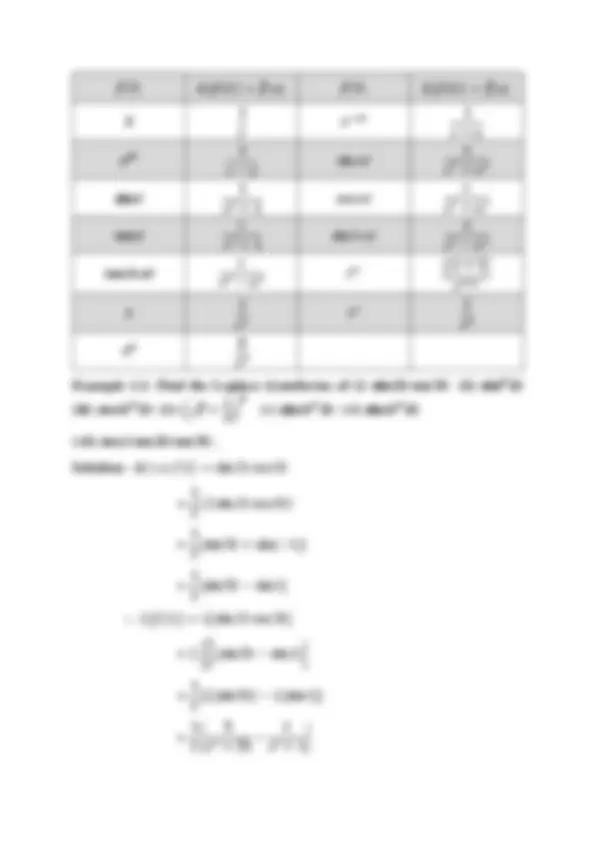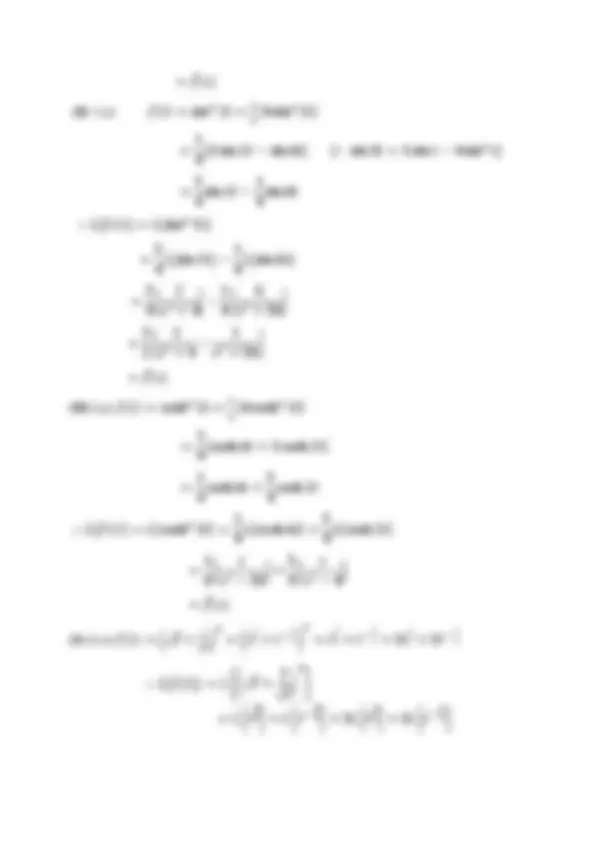





Study with the several resources on Docsity

Earn points by helping other students or get them with a premium plan


Prepare for your exams
Study with the several resources on Docsity

Earn points to download
Earn points by helping other students or get them with a premium plan
Community
Ask the community for help and clear up your study doubts
Discover the best universities in your country according to Docsity users
Free resources
Download our free guides on studying techniques, anxiety management strategies, and thesis advice from Docsity tutors
This document contains Notes and formulas of Laplace Transform.
Typology: Summaries
1 / 7

This page cannot be seen from the preview
Don't miss anything!




1.1 Introduction
The Laplace Transform is a very versatile mathematical tool which enables the
scientists and engineers to find out the solution of the initial value problems
involving homogeneous and non-homogeneous equations alike. Before the
advent of calculators and computers, the logarithms were extensively used to
replace multiplications or division of two large numbers by addition or
subtraction of two numbers. The crucial idea behind the Laplace Transform is
that it replaces operations of calculus by operations of algebra.
1.2 Definition of Laplace Transform:
Let us consider a function 𝑓(𝑡) which is defined for all the positive values of 𝑡.
Then the Laplace transform of the function 𝑓(𝑡) is defined as
−𝑠𝑡
∞
0
provided that the integral exists. Here 𝑠 is a parameter which may be real or
complex. Here 𝑓
is called the Laplace Transform of 𝑓(𝑡). The function 𝑓(𝑡),
on the other hand, is called the inverse Laplace Transform of 𝑓
(𝑠). It is
symbolically denoted as 𝐿
− 1
}. The symbol L transforming 𝑓(𝑡) into 𝑓
is
termed as the Laplace transform operator.
1.3 Laplace Transform of Some Elementary Functions:
(i) Let 𝑓
= 1 , then
−𝑠𝑡
∞
0
−𝑠𝑡
∞
0
−𝑠𝑡
(ii) Let 𝑓
𝑎𝑡
, then
𝑎𝑡
−𝑠𝑡
∞
0
𝑎𝑡
−(𝑠−𝑎)𝑡
∞
0
−(𝑠−𝑎)𝑡
Let 𝑎 → −𝑎, then
−𝑎𝑡
(iii) Let 𝑓(𝑡) = sin 𝑎𝑡, then
𝐿{𝑓(𝑡)} = 𝐿{sin 𝑎𝑡} = ∫ 𝑒
−𝑠𝑡
∞
0
sin 𝑎𝑡 𝑑𝑡
−𝑠𝑡
2
2
(−𝑠 sin 𝑎𝑡 − 𝑎 cos 𝑎𝑡)}
2
2
(iv) Let 𝑓(𝑡) = cos 𝑎𝑡, then
cos 𝑎𝑡
−𝑠𝑡
∞
0
cos 𝑎𝑡 𝑑𝑡
−𝑠𝑡
2
2
−𝑠 cos 𝑎𝑡 + 𝑎 sin 𝑎𝑡
2
2
Let 𝑎 → 1 , then
𝐿{cos 𝑡} =
2
(v) Let 𝑓(𝑡) = sinh 𝑎𝑡, then
𝐿{𝑓(𝑡)} = 𝐿{sin ℎ 𝑎𝑡} = 𝐿 {
𝑎𝑡
−𝑎𝑡
𝑎𝑡
−𝑎𝑡
[By Linearity Property]
2
2
Let 𝑎 → 1 , then
𝐿{sinh 𝑡} =
2
−𝑎𝑡
𝒂𝒕
sin 𝑎𝑡
2
2
2
cos 𝑎𝑡
2
2
2
sin ℎ 𝑎𝑡
2
2
2
2
𝑛
𝑛+ 1
2
2
3
𝟑
4
Example 1.1: Find the Laplace transforms of (i) 𝐬𝐢𝐧 𝟐𝒕 𝐜𝐨𝐬 𝟑𝒕 (ii) 𝐬𝐢𝐧
𝟑
(iii) 𝐜𝐨𝐬 𝒉
𝟑
𝟐𝒕 (iv) ( √
𝟏
√𝒕
𝟑
(v) 𝐬𝐢𝐧 𝒉
𝟐
𝟐𝒕 (vi) 𝐬𝐢𝐧 𝒉
𝟑
(vii) 𝐜𝐨𝐬 𝒕 𝐜𝐨𝐬 𝟐𝒕 𝐜𝐨𝐬 𝟑𝒕.
Solution: (i) Let 𝑓(𝑡) = sin 2 𝑡 cos 3 𝑡
2 sin 2 𝑡 cos 3 𝑡
{sin 5 𝑡 + sin(−𝑡)}
{sin 5 𝑡 − sin 𝑡}
∴ 𝐿{𝑓(𝑡)} = 𝐿{sin 2 𝑡 cos 3 𝑡}
{sin 5 𝑡 − sin 𝑡}]
[𝐿{sin 5 𝑡} − 𝐿{sin 𝑡}]
2
𝑠
(ii) Let 𝑓
= sin
3
1
4
4 sin
3
[ 3 sin 2 𝑡 − sin 6 𝑡] [∵ sin 3 𝑡 = 3 sin 𝑡 − 4 sin
3
sin 2 𝑡 −
sin 6 𝑡
∴ 𝐿{𝑓(𝑡)} = 𝐿{sin
3
𝐿{sin 2 𝑡} −
𝐿{sin 6 𝑡}
2
2
2
2
(iii) Let 𝑓
= cosh
3
1
4
4 cosh
3
cosh 6 𝑡 + 3 cosh 2 𝑡
cosh 6 𝑡 +
cosh 2 𝑡
cosh
3
cosh 6 𝑡
cosh 2 𝑡
2
2
(iv) Let 𝑓(𝑡) = ( √
1
√𝑡
3
1
2
−
1
2
)
3
3
2
−
3
2
1
2
−
1
2
3
3
2
} + 𝐿 {𝑡
−
3
2
} + 3 𝐿 {𝑡
1
2
} + 3 𝐿 {𝑡
−
1
2
}
(vii) Let 𝑓
= cos 𝑡 cos 2 𝑡 cos 3 𝑡 =
1
2
2 cos 𝑡 cos 2 𝑡
cos 3 𝑡
{cos(𝑡 + 2 𝑡) + cos(𝑡 − 2 𝑡)} cos 3 𝑡
{cos
2
3 𝑡 + cos 𝑡 cos 3 𝑡}
2 cos
2
2 cos 𝑡 cos 3 𝑡
1 + cos 6 𝑡 + cos 4 𝑡 + cos 2 𝑡
cos 6 𝑡 +
cos 4 𝑡 +
cos 2 𝑡
∴ 𝐿{𝑓(𝑡)} = 𝐿{cos 𝑡 cos 2 𝑡 cos 3 𝑡} = 𝐿 {
1
4
1
4
cos 6 𝑡 +
1
4
cos 4 𝑡 +
1
4
cos 2 𝑡}
cos 6 𝑡
cos 4 𝑡
cos 2 𝑡
2
2
2